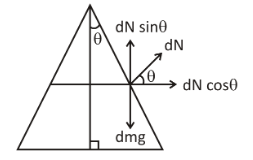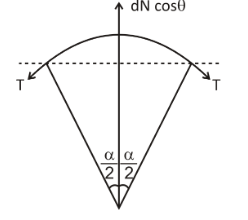Answer
414.3k+ views
Hint:Here we have to use Newton’s second law in projection form i.e, ${F_x} = m{\omega _x}$. If more than one torque operates along a fixed axis on a rigid body, the sum of the torques equals the moment of inertia times the angular acceleration.Torque is the measure of the force that can cause an object to rotate about an axis. Force is what causes an object to accelerate in linear kinematics.
Complete step by step answer:
Given, a chain of mass $m$ forming a circle of radius $R$ is slipped on a smooth round cone with half-angle $\theta $.

Each part of the chain acts on the necessary tensile stress. Therefore, we split the chain into thin, related elements in order to conclude that each element is a particle. We consider one such part of the mass $dm$ which at the middle subtends the angle $d\alpha $. With a recognised angular velocity, the chain travels around a circle of established radius $R$, and some forces act on it. We have to find one of these forces. Let us consider an element of mass $dN$.
Let its weight be $dmg$. The normal force on the cone is perpendicular. Let the angel be $\theta $. The components of the normal are $dN\sin \theta $ and $dN\cos \theta $. Let the angle formed by the radius of the circle on the circumference be $\alpha $ and the element formed is $d\alpha $.

The element formed on the circle will be in the shape of a cone.
So, mass
$
dm = \dfrac{m}{{2\pi R}}Rd\alpha \\
\Rightarrow dm = \dfrac{m}{{2\pi }}d\alpha \\ $
Here, since the element is very small, we have taken $d\alpha $.
$
dN\sin \theta - gdm \\
\Rightarrow 2T\sin \dfrac{{d\alpha }}{2} = \left( {dN} \right)\cos \theta + dm{\omega ^2}R \\
\Rightarrow Td\alpha = gdm\dfrac{{cos\theta }}{{\sin \theta }} + dm{\omega ^2}R \\
\Rightarrow T\left( {\dfrac{{2\pi }}{m}} \right)dm = g\cot \theta dm + {\omega ^2}Rdm \\
$
$\therefore T = \left( {\cot \theta + \dfrac{{{\omega ^2}R}}{g}} \right)\dfrac{{mg}}{{2\pi }}$
Hence, it is proved.
Note:There may arise some confusion while writing the angles. So we have to be very careful while putting them in the formulae. Tension can be defined as an action-reaction pair of forces acting at each end of the said elements. While considering a rope, the tension force is felt by every section of the rope in both the directions, apart from the endpoints. The endpoints experience tension on one side and the force from the weight attached. Throughout the string, the tension varies in some circumstances.
Complete step by step answer:
Given, a chain of mass $m$ forming a circle of radius $R$ is slipped on a smooth round cone with half-angle $\theta $.

Each part of the chain acts on the necessary tensile stress. Therefore, we split the chain into thin, related elements in order to conclude that each element is a particle. We consider one such part of the mass $dm$ which at the middle subtends the angle $d\alpha $. With a recognised angular velocity, the chain travels around a circle of established radius $R$, and some forces act on it. We have to find one of these forces. Let us consider an element of mass $dN$.
Let its weight be $dmg$. The normal force on the cone is perpendicular. Let the angel be $\theta $. The components of the normal are $dN\sin \theta $ and $dN\cos \theta $. Let the angle formed by the radius of the circle on the circumference be $\alpha $ and the element formed is $d\alpha $.

The element formed on the circle will be in the shape of a cone.
So, mass
$
dm = \dfrac{m}{{2\pi R}}Rd\alpha \\
\Rightarrow dm = \dfrac{m}{{2\pi }}d\alpha \\ $
Here, since the element is very small, we have taken $d\alpha $.
$
dN\sin \theta - gdm \\
\Rightarrow 2T\sin \dfrac{{d\alpha }}{2} = \left( {dN} \right)\cos \theta + dm{\omega ^2}R \\
\Rightarrow Td\alpha = gdm\dfrac{{cos\theta }}{{\sin \theta }} + dm{\omega ^2}R \\
\Rightarrow T\left( {\dfrac{{2\pi }}{m}} \right)dm = g\cot \theta dm + {\omega ^2}Rdm \\
$
$\therefore T = \left( {\cot \theta + \dfrac{{{\omega ^2}R}}{g}} \right)\dfrac{{mg}}{{2\pi }}$
Hence, it is proved.
Note:There may arise some confusion while writing the angles. So we have to be very careful while putting them in the formulae. Tension can be defined as an action-reaction pair of forces acting at each end of the said elements. While considering a rope, the tension force is felt by every section of the rope in both the directions, apart from the endpoints. The endpoints experience tension on one side and the force from the weight attached. Throughout the string, the tension varies in some circumstances.
Recently Updated Pages
Mark and label the given geoinformation on the outline class 11 social science CBSE

When people say No pun intended what does that mea class 8 english CBSE

Name the states which share their boundary with Indias class 9 social science CBSE

Give an account of the Northern Plains of India class 9 social science CBSE

Change the following sentences into negative and interrogative class 10 english CBSE

Advantages and disadvantages of science

Trending doubts
Difference between Prokaryotic cell and Eukaryotic class 11 biology CBSE

Which are the Top 10 Largest Countries of the World?

Fill the blanks with the suitable prepositions 1 The class 9 english CBSE

Differentiate between homogeneous and heterogeneous class 12 chemistry CBSE

Difference Between Plant Cell and Animal Cell

10 examples of evaporation in daily life with explanations

Give 10 examples for herbs , shrubs , climbers , creepers

Write a letter to the principal requesting him to grant class 10 english CBSE

How do you graph the function fx 4x class 9 maths CBSE



